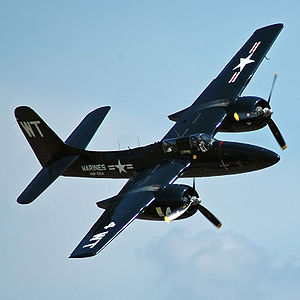F7F Tigercat
| F7F Tigercat | |
|---|---|
 |
|
| F7F-3P preserved in United States Marine Corps markings in flight. | |
| Role | heavy fighter |
| Manufacturer | Grumman |
| First flight | 2 November 1943 |
| Introduction | 1944 |
| Retired | 1954 |
| Primary users |
United States Navy United States Marine Corps |
| Produced | 1943–1946 |
| Number built | 364 |
| Variants | Grumman XTSF |
The Grumman F7F Tigercat is a heavy fighter aircraft that served with the United States Navy (USN) and United States Marine Corps (USMC) from late in World War II until 1954. It was the first twin-engined fighter to be deployed by the USN. While the Tigercat was delivered too late to see combat in World War II, it saw action as a night fighter and attack aircraft during the Korean War.
Designed initially for service on Midway-class aircraft carriers, early production F7Fs were land-based variants. The type was too large to operate from older and smaller carriers, and only a late variant (F7F-4N) was certified for carrier service.
Based on the earlier Grumman XP-50 that was eventually canceled, the company developed the XP-65 (Model 51) further for a future "convoy fighter" concept. In 1943, work on the XP-65 was terminated in favor of the design that would eventually become the F7F. The contract for the prototype XF7F-1 was signed on 30 June 1941. Grumman's aim was to produce a fighter that outperformed and outgunned all existing fighter aircraft, and that had an auxiliary ground attack capability. Armament was heavy: four 20 mm cannons and four 0.50 in (12.7 mm) machine guns, as well as underwing and under-fuselage hardpoints for bombs and torpedoes. Performance met expectations too; the F7F Tigercat was one of the highest performance piston-engined fighters, with a top speed well in excess of the US Navy's single-engined aircraft—71 mph faster than a Grumman F6F Hellcat at sea level. CAPT Fred M. Trapnell, one of the Navy's premier test pilots, opined that: "It's the best damn fighter I've ever flown." The Grumman F7F was originally named the "Tomcat" but this name was rejected as it was considered too suggestive, at the time. The name would much later be used for the Grumman F-14.
...
Wikipedia
